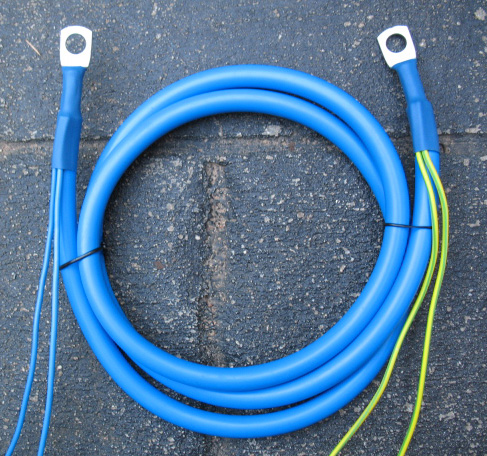Battery lead as current shunt.
A 25mm2 lug with 10mm hole was crimped on one end of a 1.7m length of 25mm2 cable along
with two 0.75mm2 wires for current sense.
Do not use one sense wire or vehicle ground as it will not work.
Using an old head light as a load, connect digital power meter to two sense wires (gnd and sensor-) and other sense wire (sensor+) to a needle.
Connect 12v battery or variable power supply and set power meter to current range required e.g 50A, 100A or 200A, if meter supports this function.
Connect 12v to 25mm2 cable and load in series and measure current passing through 25mm2 cable with digital multimeter (DMM) then using needle, penetrate
outer insulation of cable till you contact the copper wire within and note current reading on power meter.
If not the same as reading on multimeter then remove needle, move along cable and repeat untill the same reading is obtained.
If using multimeter (200mV range) instead of power meter, reading will be half multimeter current reading for 100A @ 50mV shunt and a quarter for 200A @ 50mV shunt.
Cut cable at this point and crimp lug along with two additional 0.75mm2 wires for charge/discharge current sense (3PDT switch is required) or one
additional 0.75mm2 wire for charge or discharge current sense or power meter displays both charge/discharge current.
Test new current shunt with the 0.75mm2 current sense wires and load and see if the multimeter and power meter match or is close enough, if not you may need to chop off
lug (I had to do this once, removes 20mm of wire, 10-15mm would have been spot on, measured 5A @ 4.88A before cutting, crimping wire with lug adds additional resistance) and recrimp new lug along with one or two 0.75mm2 wires for current sense.
Completed home made current shunt reads 5A for power meter and 5.01A for multimeter.
Final length of cable 1.395m, compared to 1.282m calculated, so its worth starting off with about 400mm extra length of cable.
When finished, cover barrel/sleeve of lug and part of cable insulation with heatshrink tubing to give a professional look.
Good thing about using battery lead as current shunt is your not overloading/damaging a commercial current shunt with emergency (jump starting) starter motor cranking current from auxiliary battery.
Even though its only measuring 50A, 25mm2 cable can handle a maximum current rating of 168A.
Connecting the two batteries together, has a tendency to equalize the voltage/charge on both batteries, so total cranking current is shared between both batteries.

Home made current shunt 0.001 ohms (1mV @ 1A).
A dilemma measuring current;
SEW 200/1500A digital clamp meter ST-3600 measured 4.7A.
Dick Smith 10A digital multimeter Q-1455 measured 5.00A.
Digitech 10A digital multimeter QM-1324 measured 5.03A.
Brymen 8A digital multimeter BM251 measured 5.048A.
Rough length of cable required for (will vary with cable manufacturer):
Resistance = 0.001 ohms (50A - 1mV @ 1A).
0.001 / 0.0024 (7.91mm2) = 0.417m.
0.001 / 0.00183 (10mm2) = 0.546m.
0.001 / 0.00115 (16mm2) = 0.870m.
0.001 / 0.00078 (25mm2) = 1.282m (1.395m).
0.001 / 0.000554 (35mm2) = 1.805m.
0.001 / 0.000386 (50mm2) = 2.591m.
Resistance = 0.0005 ohms (100A - 1mV @ 2A).
0.0005 / 0.00078 (25mm2) = 0.641m.
0.0005 / 0.000554 (35mm2) = 0.903m.
0.0005 / 0.000386 (50mm2) = 1.295m (1.335m).
Resistance = 0.00025 ohms (200A - 1mV @ 4A).
0.00025 / 0.000386 (50mm2) = 0.648m.
0.00025 / 0.000272 (70mm2) = 0.919m.
0.00025 / 0.0002 (95mm2) = 1.25m.
Copper resistor temperature dependence.
Resistance = R[1 + 0.0039(T - 20)]
Resistance = New resistance value
R = Initial value of resistance at 20°C
T = Conductor temperature in degrees celsius
e.g. 0.001 ohm copper resistor at 25°C
0.001[1 + 0.0039(25 - 20)] = 0.0010195 ohms
Heavy Duty Current Shunts (accuracy 0.5%).
50mV @ 50A, 1.0mOhm.
50mV @ 100A, 0.5mOhm.
50mV @ 200A, 0.25mOhm.
